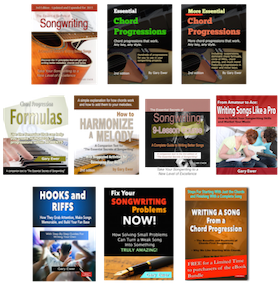Every once in a while I take a quick glance through a portion of the Rolling Stone Magazine’s “500 Greatest Songs of All Time,” and I’m looking for similarities. I’m willing to accept, of course, that the list is highly subjective, but that doesn’t bother me much. There’s no denying that the songs on the list have been influential for many of today’s established and developing songwriters, and that’s good enough for me.
When I say that I’m looking for similarities, I mean that I’m looking at the songs on a structural level, trying to see evidence of similarities that might rise to the level of being a songwriting principle.
One aspect of songwriting that jumps out to me when I glance through the list is that most successful songs use melodies that are comprised of short, repeating melodic cells. Here’s what I mean by that.
 “Hooks and Riffs: How They Grab Attention, Make Songs Memorable, and Build Your Fan Base”, is part of “The Essential Secrets of Songwriting” Deluxe 10-ebook bundle, right now being offered at a discount price. Ten ebooks all designed to help you become a more excellent songwriter. Read more..
“Hooks and Riffs: How They Grab Attention, Make Songs Memorable, and Build Your Fan Base”, is part of “The Essential Secrets of Songwriting” Deluxe 10-ebook bundle, right now being offered at a discount price. Ten ebooks all designed to help you become a more excellent songwriter. Read more..
Take song number 3 on that list — John Lennon’s “Imagine”, and you’ll see a perfect example. The verse starts with four short phrases. The melody of each phrase is the same: a leap upward of a major 3rd (“Imagine there’s no…”), followed by a descending tone (“..heaven”). This idea is replicated three more times:

The leap upward-fall downward idea is replicated, this time in an approximate way, and slightly higher in pitch:

The verse finishes with a short cell that seems different at first, but when you sketch it out you notice the similarities: the moving upward, and then the descending of the shape at the end:

When you consider the melodies of each song in the top 10, you start to notice how important this concept of repetition of a short, melodic cell is to the success of the melody. It’s nothing new, of course. Even back in classical music times, composers would create long, attractive melodies by first creating a short melodic idea, and then replicating the idea, moving it around, but always referring back to it. Beethoven’s famous first movement of Symphony No. 5 is the best example that most people will know.
Think of how much the creation of a short melodic cell contributes to the success of songs like “Satisfaction”, “What’s Going On”, “Respect”, “Hey Jude”, and so on. Creating longer melodies by first composing a cell that can get repeated has some obvious and immediate advantages:
- It forms a kind of melodic hook.
- It adds a pleasant sense of predictability to the overall melody.
- It makes it easier to sing.
- It makes it easier to remember.
You’ll be pleasantly surprised that this kind of repetition often happens naturally in your songwriting process, but if it’s not happening for you, you can still take advantage of the power of melodic cells by purposely creating them. The process of doing so is not much unlike writing a song hook:
- Write a short 1- or 2-bar melody that sits over a 1- or 2-chord progression.
- Repeat this idea once or twice, and you’ve got most of your verse in place.
- Find a good place to break away from repetition to provide something new.
In “Imagine”, Lennon breaks away from repetition when he provides the chorus melody, which he structures to be in ABAC form.
There are very few melodies that don’t use repetition as an important organizing feature. It’s a vital part of being memorable, and important enough that you should consider it a principle of song structure.
 Written by Gary Ewer. Follow Gary on Twitter.
Written by Gary Ewer. Follow Gary on Twitter.
 Get “The Essential Secrets of Songwriting”. It’s being used by thousands of songwriters to improve their technique and become better, more prolific writers. To see today’s deal, visit the online store.
Get “The Essential Secrets of Songwriting”. It’s being used by thousands of songwriters to improve their technique and become better, more prolific writers. To see today’s deal, visit the online store.











I really like this explanation of the shape of melodies – the visuals are really helpful. I use this concept a lot with my singing students to help them picture their tuning (getting them to draw a picture of the shape of the melody) , but I’d never thought about it from the songwriter’s perspective. Love it!
Very Interesting Post and well explained, A close association to this
would be (The Kernel ) used by Mc Cartney at the end of the phrases
in the verses of YESTERDAY
— DUM da da — all my troubles seemed so Dum da da–
Now it looks as though they’re Dum da da — Oh I believe in Dum da da—-